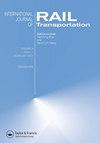三枕木夯实压载床宏细观力学特性
IF 3.6
2区 工程技术
Q2 TRANSPORTATION SCIENCE & TECHNOLOGY
International Journal of Rail Transportation
Pub Date : 2022-10-03
DOI:10.1080/23248378.2022.2129493
引用次数: 6
摘要
本文章由计算机程序翻译,如有差异,请以英文原文为准。
Macro–meso mechanical properties of ballast bed during three-sleeper tamping operation
ABSTRACT The tamping operation is an effective means to quickly restore the status of the lines. The purpose is to explore the three-sleeper tamping operation mechanism maintenance. First, a model of the interaction between tamping picks and ballast particles was proposed. Then, the model of three-sleeper tamping operation was established by discrete element method (DEM) and multibody dynamics (MBD) coupling approach. Finally, the macro–meso properties of ballast particles was analysed. The results indicate that the tamping operation can considerably reduce the compactness of the ballast bed in the bottom of the sleeper and the crib area and also disturb the ballast shoulder area. In the penetration stage, there is a critical position of normal contact force of ballast particles. Moreover, the ballast at the bottom of the sleeper can move to either side of the sleeper during the rotation stage of the retracting, which is not conducive to the compaction.
求助全文
通过发布文献求助,成功后即可免费获取论文全文。
去求助
来源期刊

International Journal of Rail Transportation
TRANSPORTATION SCIENCE & TECHNOLOGY-
CiteScore
6.90
自引率
15.00%
发文量
51
期刊介绍:
The unprecedented modernization and expansion of rail transportation system will require substantial new efforts in scientific research for field-deployable technologies. The International Journal of Rail Transportation (IJRT) aims to provide an open forum for scientists, researchers, and engineers in the world to promote the exchange of the latest scientific and technological innovations in rail transportation; and to advance the state-of-the-art engineering and practices for various types of rail based transportation systems. IJRT covers all main areas of rail vehicle, infrastructure, traction power, operation, communication, and environment. The journal publishes original, significant articles on topics in dynamics and mechanics of rail vehicle, track, and bridge system; planning and design, construction, operation, inspection, and maintenance of rail infrastructure; train operation, control, scheduling and management; rail electrification; signalling and communication; and environmental impacts such as vibration and noise. The editorial policy of the new journal will abide by the highest level of standards in research rigor, ethics, and academic freedom. All published articles in IJRT have undergone rigorous peer review, based on initial editor screening and anonymous refereeing by independent experts. There are no page charges and colour figures are included in the online edition free of charge.
 求助内容:
求助内容: 应助结果提醒方式:
应助结果提醒方式:


